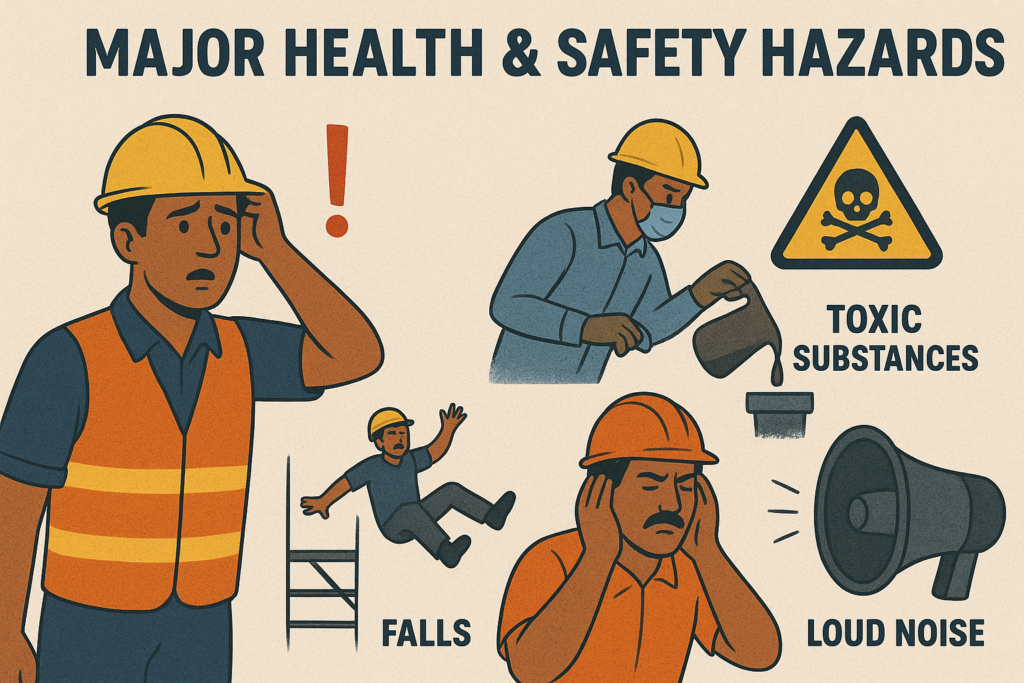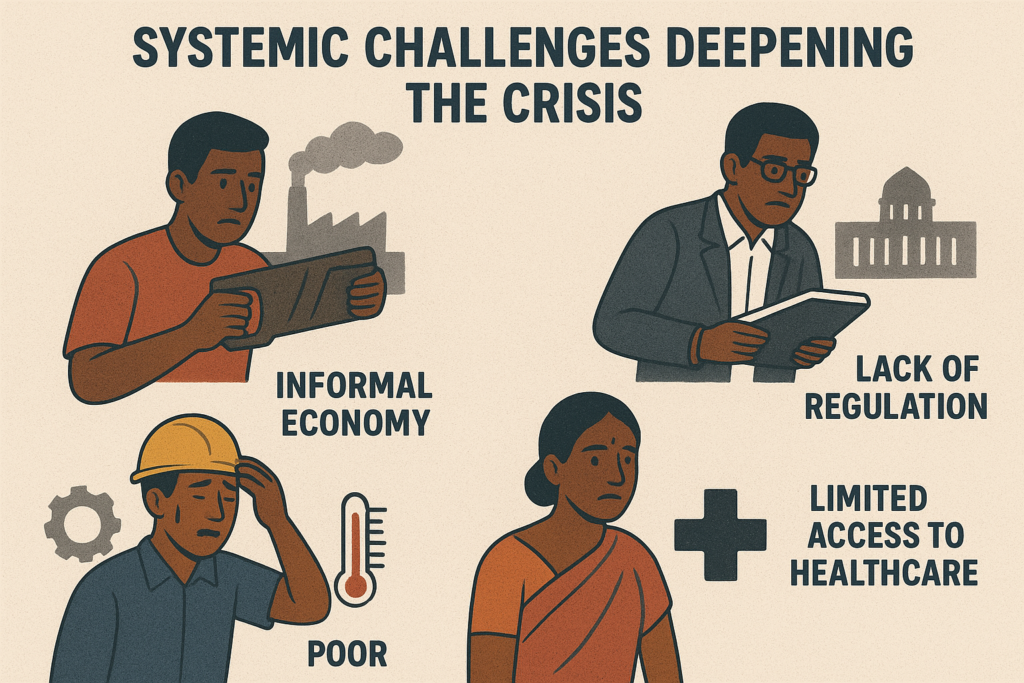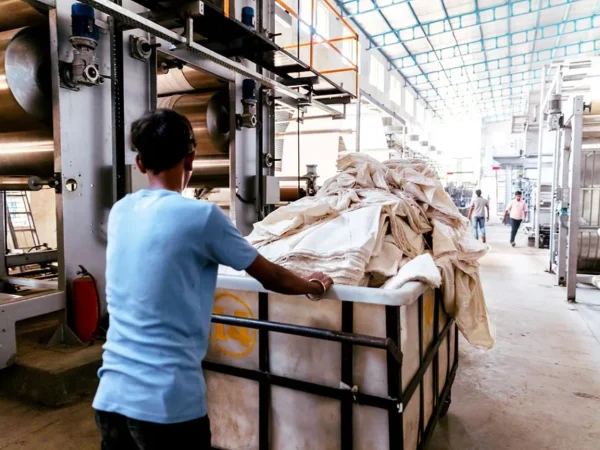India’s blue-collar workforce remains the nation’s backbone, powering sectors like manufacturing, construction, logistics, and agriculture. Despite their sheer scale and economic significance, these workers face numerous health and safety challenges that threaten their wellbeing and productivity. From workplace accidents to chronic health conditions, the complexities of India’s socioeconomic landscape compound their vulnerabilities. In this blog, let’s explore the depth of these challenges, their wide-ranging consequences, and necessary solutions for a safer future.
The Landscape of Blue-Collar Employment
Blue-collar jobs in India encompass a vast range of roles, typically involving manual labor in physically demanding industries. The sector remains largely informal, with over 90% of workers lacking formal contracts, benefits, or legal protection. Many operate in environments that are unsafe, under-regulated, and susceptible to frequent hazards
Major Health and Safety Hazards

Workplace Accidents and Injuries
Workplace accidents are starkly prevalent among India’s blue-collar workers. According to recent reports, nearly 30% of all work-related accidents in India occur in blue-collar sectors, making these workplaces among the most dangerous. Most injuries stem from equipment misuse, lack of training, and inadequate safety procedures. Machinery accidents, falls, and injuries from cutting tools are common, often resulting in lifelong disabilities or fatalities.
Electrocution and Fire Risks
Construction workers, electricians, and factory operatives are routinely exposed to live wires, faulty equipment, and flammable materials. Electrocutions at job sites are frequent, often resulting from poor insulation, lack of personal protective equipment (PPE), and insufficient safety training. Fires and burns occur regularly in factories and workshops where dangerous substances—like chemicals or spirits—are mishandled. India has one of the highest global rates for fire and burn-related workplace deaths.
Chemical Exposure
Many blue-collar workers, especially those in manufacturing and processing units, encounter hazardous chemicals daily. The absence of proper safety protocols leads to frequent chemical burns, poisoning, and increased cancer risk. Exposure to dust, fumes, pesticides, and other toxins contributes to respiratory issues, skin conditions, and chronic illnesses.
Poor Ergonomics and Musculoskeletal Disorders
Prolonged manual labor, repetitive tasks, and heavy lifting foster musculoskeletal disorders among blue-collar workers. Long hours without breaks, ill-designed workstations, and lack of ergonomic awareness result in chronic pain, joint problems, and fatigue.
Stress and Mental Health
Blue-collar roles are often marked by financial insecurity, erratic shifts, and strenuous working conditions. Workers experience high levels of stress due to job instability, wage inequality, and absence of social safety nets. The constant pressure to meet deadlines or quotas exacerbates mental fatigue, leading to anxiety, depression, and burnout.
Systemic Challenges Deepening the Crisis

Informal Employment and Lack of Protection
A vast majority of blue-collar workers in India are employed informally, without access to legal contracts, health benefits, or social security. This lack of formalization means that most workers are unable to claim compensation for accidents, illness, or occupational diseases. Wage theft, denial of rights, and exploitation are common, weakening not just worker morale but also overall productivity.
Inadequate Health Infrastructure
Most workplaces serving blue-collar workers lack adequate health facilities, first aid, and medical support. In case of injury or sudden illness, workers often have no access to immediate care, compounding the severity of their condition. Remote job sites, especially those in rural or peri-urban areas, suffer the most from poor health infrastructure.
Weak Regulatory Enforcement
Labor laws in India have made strides in protecting worker rights, but enforcement remains spotty. Many small and medium enterprises (SMEs) avoid compliance to cut costs, and inspection mechanisms are often under-resourced. Consequently, unsafe working conditions persist, and violators rarely face meaningful penalties.
Gender Inequality in Blue-Collar Jobs
Female blue-collar workers in India face additional risks—lower wages, unsafe environments, exclusion from formal roles, and harassment. Poor sanitation facilities, lack of maternity benefits, and gender discrimination deepen vulnerabilities, making the sector less inclusive and less safe for women.
Evolving Industry Risks and New Technology
As industries adopt advanced technologies, new risks emerge. For example, the use of AI-powered machinery on shop floors brings both improved safety measures and fresh challenges. Lack of training to work with new equipment can increase accidents. Moreover, silos in shift scheduling and manual operations expose organizations to compliance failures and regulatory fines.
Barriers to Health and Safety Improvements
Financial Constraints
Many blue-collar workers earn subsistence wages, rendering advanced safety equipment and healthcare unaffordable. Employers, too, may lack the resources or incentive to invest in comprehensive safety programs, especially in informal or cash-strapped sectors.
Lack of Safety Training and Awareness
A significant proportion of incidents stem from inadequate safety education. Many workers remain unaware of basic precautions, risk assessment, or emergency protocols, especially in smaller firms that do not offer regular training.
Absence of Incident Reporting Mechanisms
Without formal incident reporting systems, many workplace mishaps go unrecorded, hindering policy interventions and health monitoring. Surveillance is crucial for identifying trends, implementing targeted solutions, and generating accountability.
Impact on Workers and the Economy

Physical and Mental Health Fallout
These compounding health and safety challenges have massive effects on workers’ wellbeing. Chronic illnesses, injuries, and repeated absenteeism reduce earning capacity and quality of life. Mental health issues, often neglected in India’s work culture, lead to increased suicide rates and instability in families.
Economic Consequences
High rates of accidents and attrition undermine productivity, drive up healthcare costs, and destabilize labor markets. The economy suffers from lost man-hours, skill shortages, and high turnover, which restrict India’s ability to compete globally.
Towards Solutions: Building Safer Blue-Collar Workplaces
Policy Reform and Enforcement
Comprehensive labor reforms must focus on formalizing employment, offering social protection, and improving labor law enforcement. Governments and businesses need to prioritize safety standards, regular inspections, and stricter penalties for violations.
Robust Safety Training
Ongoing, practical safety training can drastically reduce workplace accidents. Employers must ensure workers are well-versed in risk procedures, use of protective gear, and operation of machinery.
Investment in Technology
Adopting AI-powered surveillance, automated safety checks, and advanced incident management systems can improve compliance and save lives. Digital reporting tools also help monitor risks and streamline corrective action.
Improving Health Infrastructure
Expanding access to medical care, emergency response, and occupational health services—especially at remote sites—should be a national priority. Partnerships between government, industry, and healthcare providers can foster safer, healthier work environments.
Empowering Workers
Awareness campaigns and unionization efforts are key to empowering blue-collar workers to demand fair wages, safe conditions, and legal protection. Worker involvement in site safety committees and reporting incidents ensures bottom-up accountability.
Conclusion
India’s blue-collar workforce deserves a future where their contribution is valued and protected. Addressing health and safety challenges not only saves lives—it strengthens the economy, boosts national productivity, and fosters social equity. Collaborative efforts from government, industry, and civil society are vital to ensure every worker enjoys safe, dignified working conditions, paving the way for an equitable and prosperous India.




